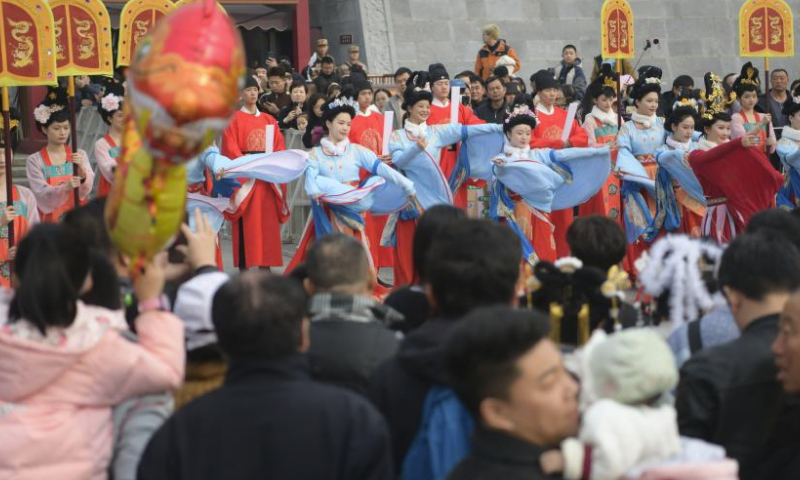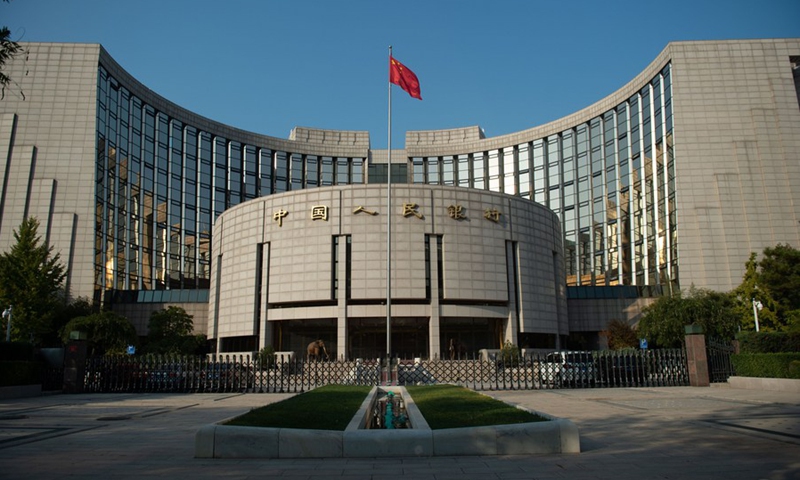
People watch a performance in front of the Yingtianmen site museum of the National Archaeological Site Park of Sui-Tang Luoyang City in Luoyang City, central China's Henan Province, Feb. 14, 2024. During the Spring Festival holiday, various cultural tourism events across central China's Henan Province have attracted lots of tourists. (Photo by Zhang Yixi/Xinhua)
China on Sunday reported record-high figures for domestic travel and spending during the just-concluded Chinese Lunar New Year holidays, with both figures also largely exceeding those of the same period in 2019 before the outbreak of the COVID-19 pandemic, further indicating that recovery in consumption is picking up pace.
The travel and spending boom during the eight-day holidays underlined improved sentiment among Chinese consumers and fully illuminated the vitality and vast potential of China's consumption market, the biggest economic growth driver, which helps brighten the outlook for China's economic recovery in 2024 and beyond, analysts said, while citing a slew of other positive factors, including policy support.
Highlighting increased policy support for the economic recovery, Chinese officials at various levels convened meetings on the first working day after the holidays to map out economic work for the rest of the year, with the focus on issues such as optimizing business environment and improving efficiency among officials.
On Sunday, Premier Li Qiang presided over the third plenary meeting of the State Council, where he called on all departments to quickly enter the work mode after the holidays, earnestly and effectively deal with various work, and strive to promote high-quality development to achieve new results, in line with the plan outlined by the Central Economic Work Conference.
Specifically, Li urged to focus on solving practical problems of concern to the public and enterprises, do more work that are conducive to boosting confidence and expectations, maintain policy consistency and stability, and take pragmatic actions to boost confidence.
Tourism boom
During the eight-day Chinese Lunar New Year holidays that ended on Saturday, 474 million domestic trips were made, up 34.3 percent year-on-year, and the total domestic tourism spending jumped by 47.3 percent year-on-year to about 632.69 billion yuan ($87.95 billion), according to data released by the Ministry of Culture and Tourism (MCT) on Sunday.
Significantly, the number of trips made during the holidays represented a 19 percent growth from the level during the same period in 2019 before the pandemic, and total spending increased by 7.7 percent from that of the same period in 2019, the MCT data showed.
Citing various favorable factors such as policies, the MCT said that "urban and rural residents' willingness to travel has increased, and many indicators such as the number of trips and total travel spending have reached record highs."
Behind the record-high headline figures are bustling scenes across the country - packed roads, airports, tourist attractions and movie theaters. South China's Hainan Province actually had to add additional flights to carry visitors home as tickets were sold out and prices skyrocketed. Meanwhile, moviegoers flocked to cinemas nationwide, generating 8.02 billion yuan in box-office revenue, a fresh record, according to data released by China Film Administration on Sunday.
All of these are vivid displays of the vitality and vast potential of the Chinese economy, analysts noted.
"[The record figures] reflect many things, one of which is the improvement of consumer confidence. Only when expectations improve are such consumption activities possible," Li Chang'an, a professor at the Academy of China Open Economy Studies of the University of International Business and Economics in Beijing, told the Global Times on Sunday. "And the consumption recovery also reflects the rebound in the overall economic vitality."
China's improved economic vitality was also evidently felt overseas, as many Chinese visited various countries in significantly large numbers during the holidays. In total, Chinese visitors made 3.6 million outbound trips, while the number of inbound trips reached 3.23 million, according to the MCT.
The National Immigration Administration said on Sunday that border checks nationwide handled about 13.52 million entrances made by Chinese and foreign travelers, with the daily average reaching 1.69 million, up 2.8 times from 2023 and reaching nearly 90 percent of the level in 2019.
Economic recovery
Jiang Yiyi, deputy head of the School of Leisure Sports and Tourism at Beijing Sport University, said the rebound in outbound tourism was supported by factors such as visa-free policies as well as the economic recovery.
"The high number of outbound trips is due to the continued and steady recovery and development of the Chinese society and economy after the pandemic," Jiang told the Global Times on Sunday.
Despite worldwide downward pressure, China's economy has remained on a stable recovery trend and that trend will further consolidate in 2024, thanks in large part to increasing policy support and improving consumer and business sentiment, analysts said.
Reflecting Chinese policymakers' laser-like focus on economic development, many provincial-level localities convened their first meeting following the Lunar New Year holidays to map out priorities for the rest of the year, with many putting emphasis on improving business environment. Shanghai, for instance, released an action plan to create a world-class business environment. East China's Shandong Province vowed to expand investment attraction, while South China's Guangdong Province emphasized on scientific and technological self-reliance.
Li said the meetings came after local governments have set their top priorities for the year during the local two sessions held later January and earlier this month and reflect the heavy emphasis on the economy, in line with priorities set by the Chinese central government.
"The meetings are an expression of confidence and mainly aimed at attracting businesses and investments, which is crucial for local economic development," Li said, noting that boosting investment is also critical.
"As we have talked about the importance of consumption, investment is also very important," Li noted. "If all localities can, based on their own local conditions, take greater policy efforts to boost investment, it would lay a very good foundation for the economic growth for the full year."
Consumption is the biggest growth driver, contributing more than 82 percent of China's total GDP growth in 2023, and investment and exports are the other two main growth engines.
While a national GDP growth target will not be released until the national two sessions scheduled to be held in early March, all the provincial-level localities have unveiled their local growth targets, with 18 economic powerhouses, including Shanghai and Guangdong, aiming for a growth rate of about 5 percent or more.

